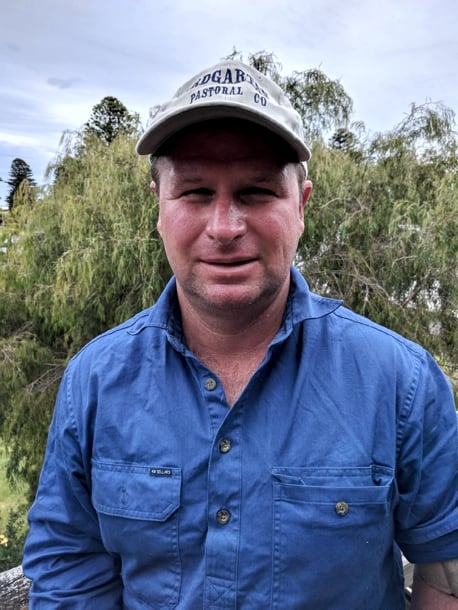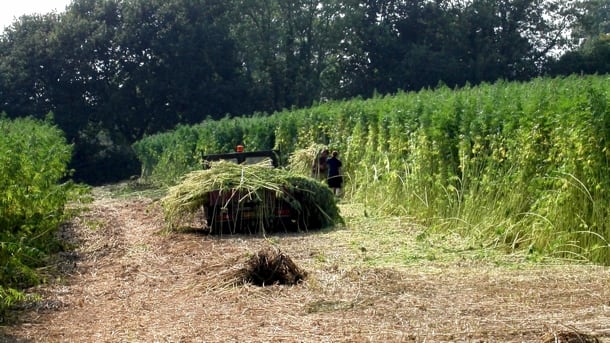Part 1: Cannabis crusaders cheer after 19 years of dashed hopes
Part 3: A novelty in Australia, hemp oil is nothing new for Kiwis
Now the legal uncertainty is out of the way, it means the near-30-year farming veteran can go ahead with plans to increase planting of hemp, leading him to benefit from increased production and improved soil for his other crops.

Besides his livestock property near Branxholme, in a high-rainfall area of southwest Victoria, he has also bought about 15,000 hectares of cropping land, where hemp “will play a critical role in the rotation of those lands,” he says.
A cattleman by trade, Youngman has gained a deep understanding of agronomy, having developed a humidified composting system that has increased grass production by 10-15% each year at his 3,200 hectare beef farm.
Hesees hemp as an important part of his cropping programme, providing a way to replenish soils that have been seriously degraded by standard farming practices.
As a rotation crop,hemp stabilises and enriches soil, leaves fields weed-free without crop toxins and doesn't compete for the best farmland. It still has a farm value even if no part of the plant is sold.
This is because fallen hemp leaves regenerate soil with nutrients, bedding and compost. Moreover, the hemp plant’s aggressive rooting structure helps anchor and aerate soil, and reduces erosion, soil loss and runoff.
The roots can also pull metals, toxins and even radioactive materials from the soil and turn them into something useful. Indeed, hemp was used at Chernobyl to extract pollutants harmlessly from the soil and groundwater.
''Its shady nature will help enormously with weed resistance, and that means that we use less or no chemicals,” Youngman says.
''From an irrigation point of view, water use efficiency is incredible; we're budgeting on just 3-6 mega-litres of water for a crop.’’
The Youngmans have so far grown two crops of hemp, albeit only at around 40 hectares each, though the seed ruling will likely lead to extrapolated production over more land “because we have the confidence that demand for the crop will increase”.
Harry aims to produce from 600 planted hectares later this year, growing to around 3,000 hectares after two years. There is still a process to go through to satisfy the legal requirements to gain a licence to grow hemp. “Nothing has changed there” in spite of the new legislation. “But we don’t mind it,” he adds.
Youngman is not the only one to look on the ruling favourably; hemp planting is now expected to explode across all suitable areas in Australia. Indeed, barely a week after the Coag decision, one company had already announced that it would establish a farmer’s cooperative in eastern Victoria, with plans to grow a first crop in September.

The Australian Hemp Manufacturing Company chose Gippsland for its first cooperative because of the quality of soil and high rainfall there.
"The food side gives us more scope and I think it opens up the industry to give us a future in another alternative farming commodity," said chief executive Darren Christie.
Meanwhile Hemp Foods Australia, one of the leaders of the movement to legalise hemp seeds over the last two decades, has set out to attract hemp growers from as far afield as Manitoba in Canada.
On the day of the Coag ruling, the company announced it would expand its operations and seek experienced hemp professionals to be part of its plans.
“Because of Manitoba’s outstanding international hemp reputation, we are specifically seeking a production manager from the area,” said chief executive Paul Benhaim.
“In addition to added job opportunities for Australia’s farming industry, this is a very positive step towards more sustainable farming,” he added.
Benhaim predicts that hemp’s market size will treble in the next 12 months, though it is difficult to put a cash value on the food segment, which was not heretofore legal. Within five years, though, he expects hemp seeds to be as common as soy, chia and flaxseed, not least because of their nutrition value.
Across the Tasman, where hemp seed oil has been legal for the last 15 years, one academic has calculated that each hectare of hemp could generate NZ$5,000-6,000 (US$3,450-4,140) per hectare in gross profit, and spur a NZ$4bn industry for the country.
Huub Kerckhoffs, of Massey University's institute of agriculture and environment, has said hemp is “definitely a competitive option”, especially with the thousands of downstream applications that stem from its production and relatively low inputs.
Yet the potential could have been even greater, according to a dejected chairman of the New Zealand Hemp Industries Association following the Coag ruling.
“After 18 years of consultation, the food ministers are still treating us like a drug crop and only allowing hemp seed foods. This is a massive missed economic opportunity,” said Mack McIntosh.
In just a short time New Zealand and Australia could have been world leaders in hemp food production beyond just the seed and grain industries.
Instead, he says the ministers’ decision means that farmers will not get access to the food and beverage market for their hemp leaves and flowering tops, which account for up to 80% of the value of the edible crop.
“The high-value nutrition potential is massive; phenols to fragrances are available from this one arable crop, and our farmers want access to the revenue streams from the whole plant, not just the seed.”
But Harry Youngman is still delighted, if also wary. Though he believes Australia’s new legal climate for hemp seed will provide a “tempting proposition for farmers”, Youngman, who supplies Hemp Foods with his crop, warns of a shortage of viable seeds that are ready to grow in tropical areas and Mediterranean-type climates.
“Those seeds just don’t exist in enough volume to grow any meaningful hectares. We are growing upside this year, so we will address and rectify that over two growing seasons,” he says.
The nature of the plant suggests that it will need to be grown over summer to create the seeds. Farmers will plant it in addition to their other crops, giving them a tool in the rotation to combat pests like annual rye grass, a notably problematic weed in Australia.
“Due to its shading nature and very aggressive growing pattern, it should be a very valuable tool in their arsenal,” Youngman says.
If things pan out, it should be a very lucrative one too.
